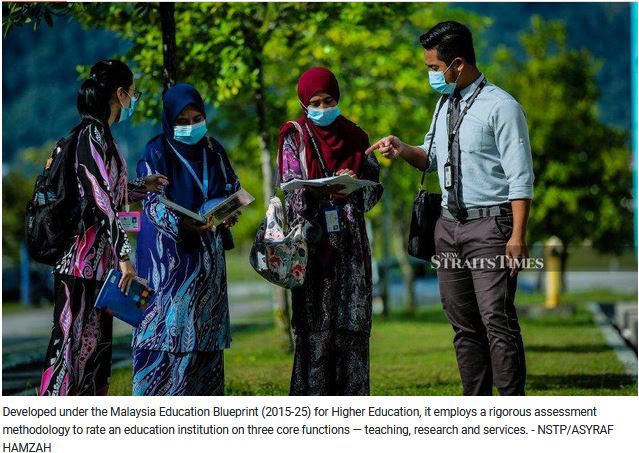Time to upgrade 'Setara', post-pandemic
Emeritus Professor Tan Sri Dato' Dzulkifli Abdul Razak
Opinion - New Straits Times
August 27, 2020
THIS year is the 5th anniversary of Setara. What is that? The word is not well promoted publicly although it concerns the public. To date, it is limited mostly to academics in institutions of higher education.
The idea of Setara is to serve as a means to "rate" public universities initially, but later extended to the private ones. Developed under the Malaysia Education Blueprint (2015-25) for Higher Education, it employs a rigorous assessment methodology to rate an education institution on three core functions — teaching, research and services.
Teaching focuses on areas like capacity of academic staff, student satisfaction on teaching and facilities, quality of graduates, internationalisation of academic programmes as well as programmes recognition.
Although measured against the same performance metric, each of the three functions has its own weightage so that their diversity, unique strengths and challenges specific to their niche are fairly represented.
In the last rating exercise in 2017, it involved universities and university colleges' status, rated and weighted in three categories based on performance: as "mature" universities, those which are over 15 years old, "emerging" universities, universities which have been established within the last 15 years, and university colleges, institutions with university college status regardless of their history.
While mature universities are expected to be more research intensive, all must involve the core functions as all good universities should be. Setara adopted the rating approach and does not use rank order.
Rather it grouped them on a star-rating from one to five (being the best). In a way, it is more comprehensive developmental in its approach and more collaborative by opening up more opportunities for learning from one another.
Moreover, it covers a wider spectrum of interests not limited to just one, like research and publication as ranking is fixated to and tends to marginalise the equally important missions of teaching and learning. So too services as rendered to the community.
Setara, therefore, takes a more open and flexible perspective that is likely to accommodate differences as an indicator of academic and education strength as well as diversity of interests.
This is apt for education where diversity is regarded as crucial.
But then, why is it rarely heard of or deemed not really making an impact on society at large? Unlike the commercially-driven ranking game that often hogs headlines for days on end, Setara takes a back seat most of the time.
It seldom causes any uproar when the expectation of being so-called "world-class" is not met. Once again, justifiably or otherwise, ranking, despite its rather narrow scope of criteria as compared with Setara, stole the show.
More ironic still is the fact that Setara involves intense site-visits to allow for verification of data sets submitted on the claims made. In other words, it provides for a better description of the institution that is being assessed, indeed approximating closer to what education is all about.
Being assessed biannually, the institution ecosystem is given ample time to better develop and undergo the needed improvement.
It is, therefore, no wonder that some experts in the field prefer national-based frameworks like Setara. It proves to be superior compared with the commercially-driven ones as it stands today.
What's more, it costs very little to participate in Setara, although it demands more stringent data points and analysis, in addition to rigorous evidence-based processes and face-to-face engagement with teams of professionals in the field.
So where has it gone "wrong" to uplift Setara as a potentially better alternative in the effort to project the stature of Malaysian education in general, and a specific institution in particular?
It is for this reason that some form of a review must be undertaken to upgrade its reputation to meet the well-intended goals as initially envisaged.
Otherwise, it remains second fiddle to the current ongoing processes. And to put "right" the distortions in conveying the true meaning of "quality" in education.
Failing which such an exercise is seen at best redundant, a mere tick-box requirement without the full benefits that could be accrued from it. More likely a waste of time and resources, especially in the post-Covid-19 pandemic.
The writer, a New Straits Times columnist for more than 20 years, is International Islamic University Malaysia rector

